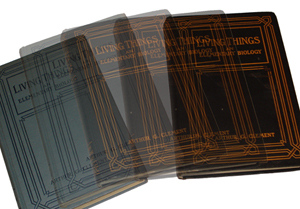November 18, 2009
The Scopes trial represented both a crisis and an opportunity for biology textbook authors and publishers.
George W. Hunter, author of the textbook at the center of the trial, was caught flat-footed. He and his publisher, the American Book Company, were midway through a scheduled revision to Civic Biology when the Scopes story went national. They soon discovered that their competitors had gotten the jump on them by publishing “acceptable” alternatives to texts like his and others not yet hip to the latest fundamentalist fashion.
discovered that their competitors had gotten the jump on them by publishing “acceptable” alternatives to texts like his and others not yet hip to the latest fundamentalist fashion.
But what constituted “acceptable?” How many compromises were required to twist biology into something a conservative Tennessee or Texas textbook committee would approve?
As luck would have it, a single textbook provides the answers.
LIVING THINGS
Living Things, An Elementary Biology by Arthur G. Clement, the “Supervisor of Biologic Science in Secondary Schools at the University of the State of New York,” was first published in 1924 under grey cover. It was an economic biology quite typical of its time. Though it broke its subject into the three common divisions – botany, zoology and human physiology – Living Things prioritized the “application of biologic principles” as they related to students and society.
After a standard introduction to basic concepts and chemistry, and following a descriptive run through the zoological spectrum, Living Things’ human physiology core offered lessons in posture, hygiene, food preparation and artificial respiration, added warnings of the dangers of alcohol and narcotics, and mixed in extremely basic descriptions of the major structures and systems of the body.
The text ended with 6 chapters devoted to “big science” applications of biology, including public health, natural resource maximization and management, plant and animal breeding and eugenics. Similar to Hunter’s 1914 Civic Biology, natural selection, described simply as “survival of the fittest,” was presented as a step toward understanding the more efficacious and useful techniques of selective breeding.
Eugenics, as was typical of biology textbooks from the late teens through the early 40s, was presented as an economic necessity, with the multi-million dollar cost to society of people born of “bad heredity,” like members of the notorious Juke and Kallikak families, clearly summed.
Living Things closed with a chapter titled “Biology and Progress.” It pitched ‘biologic’ science as a key factor in the struggle to control nature and improve human welfare. To illustrate the point, Clement profiled 6 men, Darwin, Pasteur, Koch, Harvey, Burbank and Audubon, noting their contributions to biology’s goal of control.
Living Things offered nothing particularly controversial relative to other popular textbooks. But its timing was off.
DARWIN AND THE DIRTY WORD
In a very unusual move in the conservative textbook publishing industry, the Iroquois Publishing Company reissued Living Things under a new copyright in 1925, just one year after its first printing.
What updates were made to warrant the new copyright? Aside from changing the cover color to black from grey and deleting the now dirty word “evolution” from the index, all Clement did was substitute a new 14-line section in his 22-line end-of-book Darwin biography. He simply took out a reference to the Origin of Species and replaced it with a laundry list of lesser Darwin works.
That was it. Not a single additional comma, colon or period was changed. Adaptation remained. Natural selection remained. Eugenics remained. And so did the book’s many paeans to progress and the scientific control of nature.
 After all that hoopla.
After all that hoopla.
The 1925 edition of Living Things, with its parsimoniously edited biography of Darwin, was popular enough to be reprinted at least once, in 1932, and acceptable enough to carry that great anti-evolutionist seal of approval, an inside cover stamp proclaiming the 1932 reprint, “property of the State of Texas.”
REFERENCES
Clement, Arthur G. 1924. Living Things, An Elementary Biology. Syracuse, New York: The Iroquois Publishing Company.
— . 1925. Living Things, An Elementary Biology. Syracuse, New York: The Iroquois Publishing Company.
Shapiro, Adam R. 2008. “Civic Biology and the Origin of the School Antievolution Movement.” Journal of the History of Biology 41: 409-433.

54hdwb
6166g0